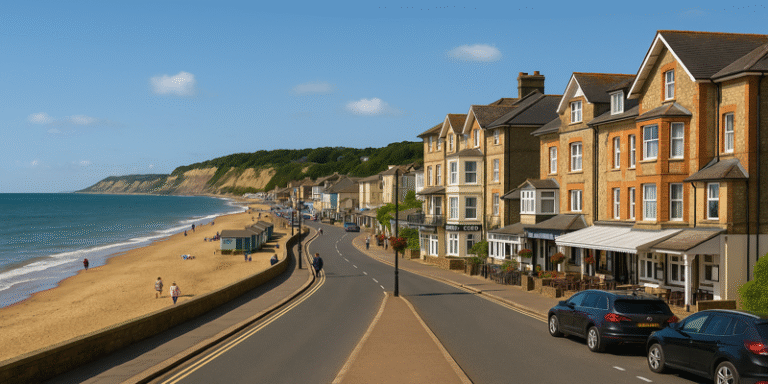Nestled on the eastern coast of the Isle of Wight, Shanklin is a charming seaside town that effortlessly blends natural beauty, Victorian heritage, and vibrant tourism. With its golden sandy beaches, quaint Old Village, and stunning Shanklin Chine, this town has long attracted holidaymakers and history enthusiasts alike. Shanklin is more than just a holiday destination—it represents a microcosm of British seaside culture and an important pillar in the local economy of the island.
A Rich History and Heritage
Shanklin’s development is deeply rooted in Victorian-era tourism, a period when seaside resorts across Britain were flourishing due to the expansion of the railway network. In the 19th century, the arrival of the railway line from Ryde to Shanklin revolutionised accessibility and ushered in waves of visitors seeking fresh sea air and rejuvenation (Munt, 2016). Shanklin’s Old Village, with its thatched cottages and traditional tea rooms, still retains much of that period charm.
A key highlight of Shanklin is Shanklin Chine, a dramatic wooded ravine carved by a stream over millennia. Not only is it a site of natural beauty, but it also holds cultural importance. During World War II, it served as a training ground for PLUTO (Pipeline Under The Ocean), a vital operation that supplied fuel to Allied forces in Europe (Turner, 2023). The Chine represents a fine example of how natural and historical elements coexist in this coastal community.
Tourism and Economic Importance
Tourism is undeniably central to the economy of the Isle of Wight, and Shanklin plays a pivotal role in this industry. According to Beatty et al. (2010), seaside towns like Shanklin are “key drivers of local employment”, especially in hospitality, leisure, and retail sectors. Visitors are drawn not only to the beaches and heritage sites but also to modern attractions such as Shanklin Theatre and family-friendly amusement arcades along the esplanade.
Despite a nationwide downturn in traditional seaside tourism in the 1980s and 1990s, Shanklin has successfully reinvented itself. By capitalising on its natural heritage and geotourism potential, including sites like Dinosaur Isle Museum, the town has diversified its tourist offerings (Munt, 2024). The rise of eco-tourism and cultural tourism has provided new life to the local economy while promoting sustainable practices.
Cultural Landscape and Community
The cultural landscape of Shanklin is a tapestry woven from local traditions, architectural heritage, and community spirit. Events such as the Shanklin Regatta, which dates back to the Victorian era, continue to be celebrated annually, bringing together residents and tourists in a festive atmosphere. Such events reinforce a sense of place identity and community cohesion, which are essential for the town’s socio-economic resilience (Clark et al., 2007).
Moreover, the integration of local geology and history into education and tourism—particularly through museums and nature trails—demonstrates how Shanklin has managed to preserve its heritage while engaging younger generations (Booth & Brayson, 2011). This dual focus on conservation and education exemplifies sustainable heritage management in practice.
Challenges and Opportunities
Like many small coastal towns, Shanklin faces a range of challenges, including seasonal employment, infrastructure strain, and the impact of climate change on its coastline. Coastal erosion threatens to alter the very landscape that makes the town attractive. Strategic management is required to address these risks and ensure the preservation of natural and built heritage (Grydehøj & Hayward, 2011).
The Isle of Wight’s inclusion as a UNESCO Biosphere Reserve offers a significant opportunity. It promotes sustainable economic growth, environmental stewardship, and cultural vitality. Shanklin, being part of this biosphere, stands to benefit from increased funding, eco-tourism initiatives, and community engagement projects (UNESCO, 2019).
In terms of economic diversification, there is growing interest in promoting creative industries and remote working hubs, which could help counterbalance seasonal dips in tourism. Improved transport links and digital infrastructure will be essential for realising these ambitions.
Future Outlook
The future of Shanklin hinges on a delicate balance between development and conservation. Policies aimed at regenerating the town centre, upgrading seafront amenities, and promoting green tourism are being explored by the Isle of Wight Council. These plans include restoring historical buildings, improving accessibility for all visitors, and incentivising local businesses to adopt sustainable practices (Marsh et al., 2023).
Community-led initiatives have also shown promise. Groups such as Shanklin in Bloom and local heritage trusts have played a pivotal role in enhancing the town’s appearance and identity. As Clark, Southern and Beer (2007) argue, empowering local governance is key to fostering long-term sustainability in rural and coastal towns.
Shanklin Town remains one of the Isle of Wight’s most beloved seaside destinations, offering a unique blend of natural beauty, historic charm, and vibrant community life. From its picturesque Old Village to the dramatic vistas of Shanklin Chine, the town continues to enchant visitors while adapting to contemporary challenges. Through a commitment to sustainable tourism, cultural preservation, and community empowerment, Shanklin is charting a course for a resilient and prosperous future.
References
Beatty, C., Fothergill, S., Gore, A. & Wilson, I. (2010) The Seaside Tourist Industry in England and Wales. Sheffield Hallam University. Available at: https://shura.shu.ac.uk/26340/.
Booth, K.A. & Brayson, J. (2011) Geology, landscape and human interactions: Examples from the Isle of Wight. Proceedings of the Geologists’ Association, Elsevier.
Clark, D., Southern, R. & Beer, J. (2007) Rural governance, community empowerment and the new institutionalism: A case study of the Isle of Wight. Journal of Rural Studies, 23(2), pp.254-266.
Grydehøj, A. & Hayward, P. (2011) Autonomy initiatives and quintessential Englishness on the Isle of Wight. Island Studies Journal, 6(2), pp.179–202.
Marsh, N., Owen, J., & Jones, S. (2023) Visions of Sandown: Partner Report for Isle of Wight Council. University of Southampton. Available at: https://eprints.soton.ac.uk/494307/.
Munt, M.C. (2016) Geoheritage Case Study: The Isle of Wight, England. In: Hose, T.A. (Ed.) Geotourism: A European Perspective.
Munt, M.C. (2024) Being in the Right Place, Dinosaur Isle Museum, Isle of Wight. Geoconservation Research. Available at: https://oiccpress.com/gcr/article/view/8240.
Turner, W. (2023) A-Z of the Isle of Wight: Places – People – History. Amberley Publishing.
UNESCO (2019) Isle of Wight Biosphere Reserve Nomination Form. Available at: https://unesco.org.









